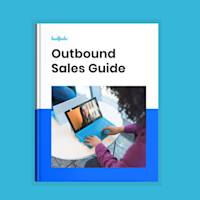Technology has made it cheaper, easier, and faster to contact people. The online noise is growing and it's likely to continue indefinitely for our perceivable lifetimes.
How does this impact your sales team, your SDRs, and your customers?
It makes it harder to reach prospects and it can make cold calling all but obsolete. But that doesn't mean that outbound is gone — it does mean shifting the way outbound prospecting is done.
Recently, Andy from our Leadfeeder team sat down with Aaron Ross, the author of Predictable Revenue and From Impossible to Inevitable to discuss how to build a consistent source of outbound prospects.
Over the years, Aaron has worked with several large companies like Salesforce to grow their revenue by $100 million. (Nope, not a typo 😱)
If you want to get smarter about outbound sales prospecting (and build a predictable stream of prospects), this is a webinar you won't want to miss.
P.S. If you want to watch the entire webinar (along with the Q&A) here's the full video.
Note: Ready to achieve sales success with outbound prospecting? Try Leadfeeder free for 14 days to learn more about your prospects such as the companies they are from, pages they visit, and content they like.
Wait, what does predictable revenue mean?
Before we dig into the tips, I want to cover one of the main terms Aaron uses — predictable revenue. What does it actually mean?
The goal of predictable revenue is to find that magic moment when you close deals regularly, from a predictable source of quality prospects.
Rather than finding things that work once or for a few years, you build a framework that provides reliable (and yes, predictable) growth over time.
It means no more tossing spaghetti at the wall to see what sticks. It's taking a formulaic approach to drive leads over and over again.
So, how do you get there?
Make sure your top of the funnel is consistent
The first step Aaron talks about is creating consistency at the top of your funnel.
Where does your revenue come from? What are the lead sources of your revenue?
Many companies don't know, or they can't break it down into what's organic versus paid, what is predictable, versus plateau-able.

How can you consistently create meetings with new accounts, new companies, new prospects?
If you don't build the skill to go out and talk to new customers who don't know you, then at some point you're gonna plateau in your pond. (Hello, outbound prospecting.)
There are really three different ways to get those top-of-the-funnel leads: seeds, nets, and spears.
Understand seeds, nets, and spears
If you've read any of Aaron's books, you may be familiar with the three types of prospects he talks about: seeds, nets, and spears.
Understanding the difference between these is crucial to growing outbound sales because each of these prospects needs to be treated a little differently.
Here's a quick outline of each type:
Seeds are the word of mouth referrals. You want as many of these as you can get because these are the best leads. But, they do have one disadvantage — they are hard to generate and hard to predict.
Nets are inbound marketing strategies like content marketing where you use content to gain interest and draw in prospects. There are a lot of advantages of this method but it can plateau and tends to be a quantity over quality type of program.
Spears is outbound prospecting and outbound business development. This is the key to creating predictable revenue. You have a human who is building a targeted list and reaching out to set up appointments with people who usually don't know you.
Remember all three of these are effective; they're just a bit different.
Understanding the differences — and being able to separate those efforts — is key to creating a predictable stream of prospects.
Nail your niche
Who is your ideal customer? The ones who have a specific pain point that you are uniquely qualified to solve. You know how to talk to them in their language and to help them see the value in what you have to offer.
These are easy wins.

Make sure you dig deep and really understand who, exactly, is interested in what you have to offer. This stops you from spending too much attention on prospects that take longer to convert — or might not convert at all.
Start thinking about how to address the people in your niche. What language should you use, what problems are they having, how can you help them? Outbound prospecting will go much smoother when you are reaching out to the right people from the start.
Separate inbound and outbound roles
Ideally, the word-of-mouth or content marketing net leads get fed into an inbound SDR, who pre-screens and qualifies them before they go to salespeople. While outbound prospecting is handled by the outbound SDRs.
Most companies have these teams, but they often mix up the roles. They have these junior salespeople, BDRs of SDR responding to inbound leads and doing outbound prospecting.
It's all leads, right? It shouldn't matter.

On the surface, they sound similar because there are appointments and emails and phone calls and they're passing prospects on to salespeople.
But the jobs are completely different because the mindset, the compensation, the metrics, the methodology, the messaging, the rhythms, the tools you use are all different.
Combining these roles is shooting yourself in the outbound foot. These are completely different jobs. It's inbound SDR and outbound SDR role.
So do not mix them, except for a really, really good reason.
Are you ready to grow?
Maybe you are thinking, your sales process is fine. We just need more meetings and we're ready to grow.
Sometimes that's true, and sometimes, honestly, it's not.
Do a reality check, are you really ready to grow? Do you have the processes in place, the customer service down, the team to handle growth? Sometimes that's a yes and sometimes that's a no.
Do you have successful customers and employees and a product-market fit? The best outbound prospecting process in the world won't help you if your business isn't prepared to grow.
Before you focus on outbound prospects, make sure you've got something that's worth growing, something that's ready to grow.
Conclusion
Growing your outbound prospecting process starts with finding the right leads — and that's where Leadfeeder shines. Sign up for a free Leadfeeder account to start turning website traffic into leads.
Note: Ready to achieve sales success with outbound prospecting? Try Leadfeeder free for 14 days to learn more about your prospects such as the companies they are from, pages they visit, and content they like.
Now that you're here
Leadfeeder is a tool that shows you companies that visit your website. Leadfeeder generates new leads, offers insight on your customers and can help you increase your marketing ROI.
If you liked this blog post, you'll probably love Leadfeeder, too.
Sign up


![Outbound Masterclass: Cold Call, Email, and Social Sell like a Pro [Webinar Recap]](http://images.ctfassets.net/plii0v5gbc4s/7GJqPNyHCks6PiDbrSLS1s/bed1a5f8eb0fb7d0e4a106be34ff55c4/outbound-sales-masterclass-webinar-recap.png?w=686&q=80)






